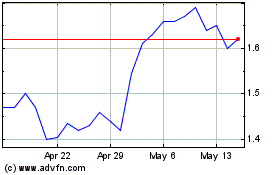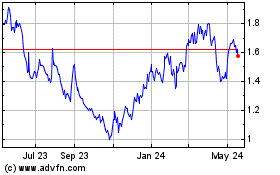Spero Therapeutics Announces Publication of SPR720 Phase 1 Lung Exposure Data in Antimicrobial Agents and Chemotherapy
03 October 2024 - 6:30AM

Spero Therapeutics, Inc. (Nasdaq: SPRO), a multi-asset
clinical-stage biopharmaceutical company, focused on identifying
and developing novel treatments for rare diseases and multi-drug
resistant (MDR) bacterial infections, today announced the
publication of data from its Phase 1 clinical trial, which assessed
the intrapulmonary pharmacokinetics (PK) of SPR719. The full
manuscript, titled “Intrapulmonary pharmacokinetics of SPR719
following oral administration of SPR720 to healthy volunteers” was
published ahead of print in Antimicrobial Agents and Chemotherapy.
A copy of the paper can be accessed here.
SPR720 is an oral, chemically stable phosphate
ester prodrug that is converted rapidly in vivo to SPR719, the
active moiety. SPR719 targets the ATPase site of DNA gyrase B in
mycobacteria, a mechanism that is distinct from that of other
antibiotics in use for Non Tuberculous Mycobacterial- Pulmonary
Disease (NTM-PD).
“The Phase 1 study is part of a series of
studies Spero is conducting in order to explore the potential of
SPR720 as a treatment for NTM-PD,” said Sath Shukla, President and
CEO of Spero. “Effective oral therapy for NTM lung disease requires
adequate uptake into the pulmonary epithelial lining fluid and
alveolar macrophages, where mycobacteria reside and proliferate.
The results of this Phase 1 study suggest that SPR719 (the active
moiety of SPR720) had significant lung uptake and enhanced
concentrations in these compartments.”
Background
- This study was designed to
determine safety and intrapulmonary PK of SPR719, including
concentrations in pulmonary epithelial lining fluid (ELF) and
alveolar macrophages (AM) in the lung to provide essential dose
selection information for the development of SPR720 for the
treatment of NTM-PD.
Study Highlights
- This was a Phase 1, single-center,
open-label study in healthy adult male and female subjects.
Subjects received a 1,000 mg dose of SPR720 administered once daily
for 7 days. Blood samples were collected for plasma pharmacokinetic
assessments. Each subject also underwent a standardized
bronchoscopy and Bronchoalveolar Lavage (BAL) on Day 7. The safety
population comprised 33 healthy adult subjects, and the PK
population included 30 subjects.
- There were no meaningful
concentrations of SPR720 detected in the plasma. Mean plasma
concentrations of SPR719 reached a peak at approximately 4 hours
and then declined over the remaining 24 hours.
- The concentrations of SPR719 in ELF
and AM were found to be greater than total plasma
concentrations.
- These results suggested that SPR719
had significant lung uptake and enhanced ELF and AM concentrations
because unbound plasma concentrations predominantly influence
penetration into lung compartments.
- No unexpected safety findings were
observed.
- Results from this study of the
intrapulmonary disposition of SPR719 support further investigation
of SPR720 as a potential oral agent for treatment of NTM-PD.
Upcoming Presentation at
IDWeekData from in vitro evaluation of the development of
microbial resistance against SPR719 have been accepted for
presentation at IDWeek, taking place October 16 to 19, 2024 in Los
Angeles, CA.
About Nontuberculous Mycobacterium
Pulmonary Disease (NTM-PD)NTM-PD, also known as NTM lung
disease, is caused by bacteria naturally found in soil, dust, and
water. These bacteria belong to the Mycobacterium family, excluding
those that cause tuberculosis and leprosy. The most common cause of
NTM infections is the Mycobacterium avium complex (MAC).
NTM is a growing global health concern with significant unmet
medical need. Although rare, the incidence of NTM pulmonary disease
is increasing worldwide. It is estimated that approximately 130,000
patients suffer from NTM in the U.S. and Europe, a figure that is
growing at a rate of 8% annually. Patients with NTM lung disease
experience progressive symptoms, lung damage, and reduced quality
of life due to chronic symptoms and impaired lung function. NTM
infections can occur after surgery, trauma, injections, or exposure
to contaminated water. Prevention involves effective water
management programs in healthcare facilities, and treatment
typically requires consultation with infectious disease or
pulmonary specialists. Patients currently have limited treatment
options for NTM lung disease.
About Spero
TherapeuticsSpero Therapeutics, headquartered in
Cambridge, Massachusetts, is a multi-asset clinical-stage
biopharmaceutical company focused on identifying and developing
novel treatments for rare diseases and MDR bacterial infections
with high unmet need. For more information, visit
www.sperotherapeutics.com
Forward Looking StatementsThis
press release contains forward-looking statements within the
meaning of the Private Securities Litigation Reform Act of 1995, as
amended, including, without limitation, statements regarding the
timing, progress and results of Spero's preclinical studies,
clinical trials and research and development programs; and the
potential benefits of any of Spero’s current or future product
candidates in treating patients. In some cases, forward-looking
statements may be identified by terms such as "may," "will,"
"should," "expect," "plan," "aim," "anticipate," "could," "intent,"
"target," "project," "contemplate," "believe," "estimate,"
"predict," "potential" or "continue," the negative of these terms
or other similar expressions. Any forward-looking statements in
this press release are based on management’s current expectations
and beliefs and are subject to a number of important risks,
uncertainties and other factors that may cause actual results to
differ materially from those indicated by such forward looking
statements, including whether tebipenem HBr, SPR720 and SPR206 will
advance through the clinical trial process on a timely basis, or at
all, taking into account the effects of possible regulatory delays,
slower than anticipated patient enrollment, manufacturing
challenges, clinical trial design and clinical outcomes; whether
the results of such trials will warrant submission for approval
from the FDA or equivalent foreign regulatory agencies; whether the
FDA will ultimately approve tebipenem HBr and, if so, the timing of
any such approval; whether the FDA will require any additional
clinical data or place labeling restrictions on the use of
tebipenem HBr that would delay approval and/or reduce the
commercial prospects of tebipenem HBr; whether a successful
commercial launch can be achieved and market acceptance of
tebipenem HBr can be established; whether results obtained in
preclinical studies and clinical trials will be indicative of
results obtained in future clinical trials; Spero's reliance on
third parties to manufacture, develop, and commercialize its
product candidates, if approved; Spero's need for additional
funding; the ability to commercialize Spero's product candidates,
if approved; Spero's ability to retain key personnel; Spero's
leadership transitions; whether Spero's cash resources will be
sufficient to fund its continuing operations for the periods and/or
trials anticipated; and other factors discussed in the "Risk
Factors" set forth in filings that Spero periodically makes with
the SEC. The forward-looking statements included in this press
release represent Spero's views only as of the date hereof and
should not be relied upon as representing its views as of any
subsequent date. Except as required by law, Spero explicitly
disclaims any obligation to update any forward-looking
statements.
Investor Relations Contact:Shai Biran, PhDSpero
Therapeutics IR@Sperotherapeutics.com
Media Inquiries:
media@sperotherapeutics.com
Spero Therapeutics (NASDAQ:SPRO)
Historical Stock Chart
From Dec 2024 to Jan 2025

Spero Therapeutics (NASDAQ:SPRO)
Historical Stock Chart
From Jan 2024 to Jan 2025
